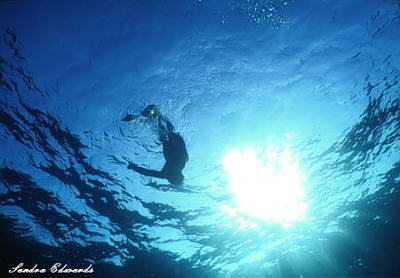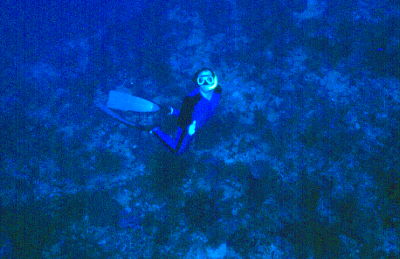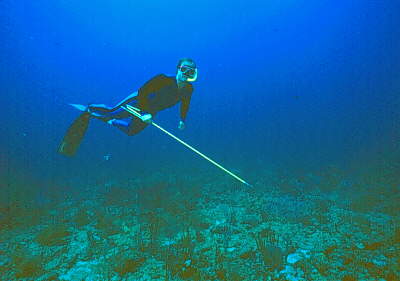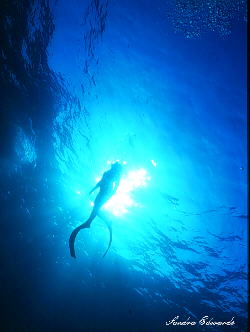
- Other Issues
- >> How to learn the "Zen of Ocean Existence....the Tao of Freediving"
| Free-Diving... ...Most people don't do it...That is, they don't dive for free, and they have never really learned how to freedive. There is a growing movement in Palm Beach Florida for the purity, the renaissance, the eco-bonding, and the intensity of freediving. |
| You float on the surface, breathing deep and slowly, watching the bottom 40 feet below you...In tune with your body, you begin to slow your hear rate down....100...90...80..70...65...55 beats per minute.... |
 |
With a last completely full breath, you jackknife, your feet rise up out of the water and their weight above its surface begins to thrust your body downward. |
 |
You take big, almost stiff-legged kicks, very slow frequency, but with large amplitude. You almost try to sleep your way down to the bottom, staying as relaxed as possible, exerting the minimum amount possible. |
 |
Twenty seconds later you are moving along the bottom about 50 feet deep, effortless and free, watching the antics of damselfish, triggers and the constant schools of mangrove snappers among the bright hues of sponges, gorgonians, and complex coral colonies. |
 |
You glide along at close to twice the speed you could have traveled with scuba gear on, but with virtually no exertion. Your fins are close to twice as long as the sluggish versions made for most scuba divers, and amazing flexibility of them allows huge thrust with little muscular contraction. |
| You begin to imagine the efficiency of function a fish or dolphin must realize with their superior hydrodynamic designs, and wonder why you took so long to experience this natural euphoria.
Just ahead of you a 25 pound hogsnapper changes color from sandy beige to orange , and heads in your direction. You instantly become a human targeting mechanism, calculating his trajectory, speed and potential directions, and then reach out to take aim...Snap. ..One 35 mm photo of a very cool fish trying to blend into one of the most spectacularly colorful environments on the planet! |
 |
You tilt upwards and begin a slow frequency, big amplitude kick toward the surface 50 feet above you. You stay relaxed, you maintain a slow steady kick, and the surface approaches. |
You hit the surface exhaling hard through the snorkel, and the fresh taste of air has never felt so good. Your body feels somewhat heavy all over, from lactate developed throughout your body as it was forced to power you with anaerobic metabolism. You now pay back the oxygen debt, converting the blood lactate to a form of blood sugar (pyruvate), and your muscles begin to "sing" with new energy and they feel great. Its a perfect workout. Your focus and concentration improves with each dive, and the euphoria of the activity keeps you compelled towards several hours of more freedives until exhaustion suggests you retire until your next opportunity on another day. This "Renaissance" in Freediving we are talking about in Palm Beach, can be observed on the two main reef tracts. The first, with an average depth of from 10 to 20 feet, is enjoyed by beginning divers for its gentle challenges, but still exciting marine life. The second, from 40 feet to 60 feet deep, attracts intermediate and advanced freedivers with its spectacular and lush reef crown and ledges, and very large fish populations. Beginners can enjoy the 40 foot reef as well, but should do so with the supervision of a charter boat, just as if they were scuba diving. There are over 20 miles of reef tracts to be explored, but these lines of reef are more continuous on the 40-60 foot reef than the 10 to 20 foot reef. For this reason, we are portraying two of the most prolific areas, and showing how local freedivers find there way and enjoy these reef lines. With the disgusting level of litigation in America, we can't say that "This is where you should freedive, and this is how to do it safely", but we can tell you how locals enjoy freediving in Palm Beach County. Boynton Beach has a great place which locals and tourists can use to access the reef systems. An oceanfront hotel, the Palm Beach Hawaiian, is located on a beach right in front of a novice snorkeling reef. The Hotel rents Kayaks, so snorkellers can rent a boat which they can reach a dive site with, and then tow behind themselves with less effort than pulling a float ball. If you plan on visiting here and renting a kayak, make sure you call ahead and reserve one. The number is 1-305-921-8944 (Waterways Kayak--they have an arangement with the hotel for three day to longer rentals, where you will havve one reserved and broght out for you). Option one is what we will call the shallow reef in 10 to 15 feet of water, located about 100 yard out (but varying further or closer over the many miles of shallow reef). A nice section exists by the Palm Beach Hawaiian, just north (100 feet) or just south of it (100 feet)...if you paddle straight out there is a gap in the reef so you could miss it. While it is possible to snorkel without a kayak for very experienced freedivers, safety is enhanced a great deal by pulling one behind you (kayaks are much bigger and easier to see than a Diver Down Flag by itself, and people in motor boats are your principle safety concern as a freediver.) If you like you can rent a Kayak at the Hawaiian Inn, or you can bring your own and launch from their beach. The other entry level option, we will call this option #2, is on the shallow Breakers Reef right off the shore by Worth Ave., Palm Beach. Again, a kayak is desirable to ward off boaters, and as a rest platform, but strong swimmers often just swim out and tow a float flag. This area is best experienced for the first time on a weekend, when you can see a line of dive boats and flags on this shallow reef already, so you can find the best parts of the reef to start with by heading over to the dive traffic you see. Several of the local freedivers used charter boats with scuba divers on them for their first few dives on this reef line, to learn the best areas and what to look for in shore markings, and now they just swim out or kayak. Option #3 is used by the freedivers who paddle out from the Hawaiian to the 40-60 foot reef. They either rent or bring their own Kayak, and paddle out until the visual markings of the shore line up so that they can tell they are over the reef. They then pull the kayak (and dive flag it flys) as they begin their leisurely cruise with the current along the reef. Some locals will drift this reef from the Hawaiian to Breakers, where they will come back into shore and carry the boats back by car top (this requires one dive buddy to park here prior to diving, then to ride over to the Hawaiian in the other car which is left at the hotel. Freedivers with the inflatable Aire Kayaks have the option of deflating when they get to shore, and fitting the boat into a taxi or into any car they can arrange to pick them up at a specified time. Those desiring shorter duration dive outings will come to shore at the Lake Worth Pier area. And option #4 would be used by the freedivers who put in at the Lake worth pier, and come back in at either the Worth Avenue area of Palm Beach, or by the Breakers Hotel. In his excellent book on Diving Locations, Dr. Ray McKallister has all the tools you will need to find both the best reefs for freediving and the shore locations in which you may want to put in. Equipment for Freediving Most important is your choice of fins. For a mask, you want very low volume, and a very soft, comfortable skirt so your face seal is perfect for many hours at a time in the water. Snorkels are an area of some choice---many freedivers prefer a simple but quality J shape design, such as the Scubapro snorkel for about $18. NO flexible hose models, they are inferior. Some people opt for the expensive multiple purge snorkels, costing as much as $70... They are known as "Dry Snorkels" which they are, but with more drag and more cost, many of us believe learning how to use the J snorkel is the practical solution. Wetsuits/skinsuits...You need at least a skinsuit to protect you from stinging organisms like larval jellyfish, and with many hours in the water a wetsuit is better at keeping you comfortable by preventing as much heat loss. Cameras/video/spearguns If you want to spearfish, you need first to decide what size fish you would like to eat / believe you can find and catch...for fish under 20 pounds, most divers will opt for a gun with a barrel length of about 42-48 inches, with the spear just barely protruding beyond. For fish under 10 pounds, you can go with the 36 inch guns, and the maneuverability and ease of use for both of these size ranges is excellent. For divers intent on much larger fish, whether its 100 pound tuna or 60 pound grouper or African Pompano, a 60 inch barreled gun is preferred for its much larger range and hitting power, but the rapid aiming possible on the smaller guns is sacrificed. How to get to be good at freediving If you really want to get good, you can sign up for a freedive clinic, such as the ones to be offered with world famous freediver Terry Maas, in Palm Beach in April/May. It will be a two day seminar of as much freediving as you can handle and as much knowledge as you can absorb. Terry will be teaching the fine art of breathold (or Apnea) techniques, perfect finning form and how to stalk fish (even where to LOOK for fish on a reef ---ever see how some divers seem to have fish approach them constantly, while others buzz all over and never find any?). There will also be a portion of this class devoted to basic dive Kayak skills for those who are interested. Check back to this freediving section again soon, as we will be updating it with more information about the classes. |
| [ HOME ]- [ ABOUT ] - [ Freedive Seminar ] - [DIVE BOATS, DIVE STORES, & HOTELS] [ FREEDIVE EQUIPMENT ] |